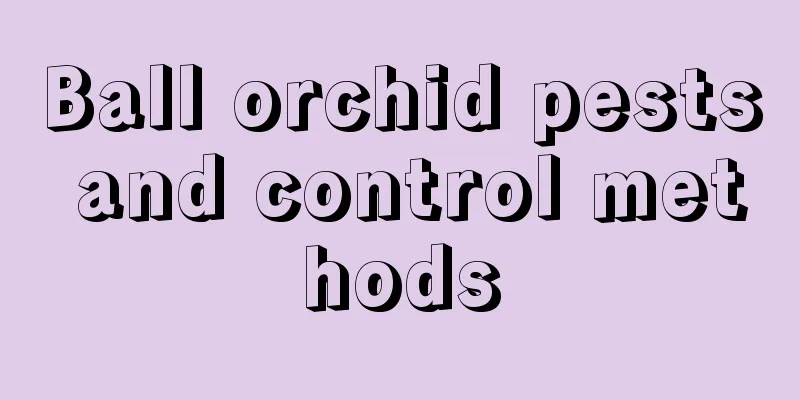Ball orchid pests and control methods

Ball orchid pests: scale insectsSymptoms of harmScale insects often parasitize on leaf sheaths and stems, especially in dark places such as the back of leaf sheaths. They use their piercing-sucking mouthparts to penetrate deep into the plant's stomata to absorb nutrients. This has a great impact on the growth of Hoya, causing the seedlings to gradually wither and turn yellow, and make them susceptible to disease and death. In summer, with high temperatures and heavy rains, poor ventilation or insufficient sunlight, scale insects are very likely to cause damage. Prevention and treatment methodsPay attention to ventilation and detect insects early. When a small number of insects occur, use a brush to brush them off and then rinse them with water. When pests occur on a large scale, chemical methods are used for prevention and control. During the peak period of nymph hatching, spray the pesticide 1 to 3 times. For example, spray 80 % DDT emulsifiable concentrate or 1000 times diluted 3 % pyrethroids once every 7 to 10 days for 3 times. Hoya pests: aphidsSymptoms of harmThere are many types of aphids. They are common insects with small and soft bodies. They often gather on the young stems of branches and leaves to absorb nutrients, causing the growth of the affected plants to stagnate and the leaves to turn yellow. Its secretions often lead to the parasitism of various molds, and are particularly prone to causing sooty mold disease. Prevention and treatment methodsWhen insect pests occur in small quantities, wash the leaves with water or soapy water, or remove the affected parts. For chemical control , you can use 1000-1500 times solution of cypermethrin or 1000 times solution of dichlorvos for spraying once every 5-7 days for 3 consecutive times, which has a better control effect. Ball orchid pests: mitesSymptoms of harmMite pests are mainly red spiders, yellow spiders and false spiders, which are most likely to occur in dry and high temperature environments. The small insects parasitize on the leaves. When there is sunlight, they often live on the back of the leaves or on the leaf sheaths, absorb nutrients from new buds and leaves, and cause the leaves to change color. The affected leaves often have a patch of grayish-white spots, which then become rough, irregular silver-gray or gray-brown spots or patches. In severe cases, silk-net-like leaves can be found on the back of the leaves, which gradually develop scorched yellow dents and quickly shrink and deform. Prevention and treatment methodsSpray the upper and lower surfaces of the leaves with soapy water. The soapy water can adhere to the leaves and form a thin film to prevent or reduce the parasitism of mites. Spray with chemical agents such as cypermethrin and cypermethrin. When spraying, spray the upper and lower surfaces of the leaves and the base of the leaves. Spray once a week for 3 consecutive times. |
<<: Horse Chestnut Pests and Diseases and Control Methods
>>: White crystal chrysanthemum pests and control methods
Recommend
How to propagate Mo Lan
Growth habits of Molan Mo Lan prefers warm and sh...
Can strawberries be grown in the north?
Can strawberries be grown in the north? Strawberr...
The functions and taboos of soaking roses in water, how many roses should be put in the water
1. Function 1. Beauty and skin care: It contains ...
These 7 kinds of flower scents are poisonous, so don’t put them in your bedroom! A must-see for families with elderly and children!
Lily Reasons for prohibiting bedroom: The scent o...
Is the purple pearl succulent poisonous?
Do not allow direct skin contact with its juice I...
How many years does it take for a kiwi tree to bear fruit?
Introduction to Planting Kiwifruit Trees When pla...
The meaning of carnations, who should we give carnations to?
1. Flower Language Its flower language is very di...
How to grow Chlorophytum and Pothos and precautions
Growth habits of Chlorophytum comosum Chlorophytu...
The efficacy and function of silver-edged spider plant
Overview of the efficacy of silver-edged spider p...
Cultivation methods and precautions of the rich tree
Cultivation methods and precautions of the rich t...
How to cultivate iron jasmine
1. Proper lighting Jasmine loves sunlight very mu...
Can azaleas be planted in the ground?
Can azalea be planted in the ground? Rhododendron...
What to do if the leaves of seven-leaf lotus produce oil
The reason for this situation First of all, we mu...
What are the benefits of eating hawthorn? How to eat hawthorn
1. What are the benefits of eating hawthorn 1. Pr...
Does French perfume jasmine need to be topped?
1. Do you want to top it? To control the height o...









